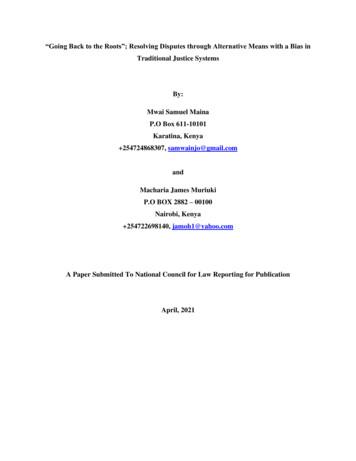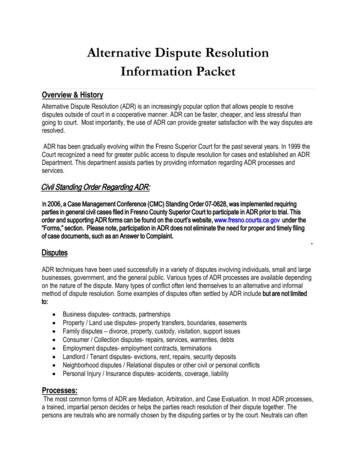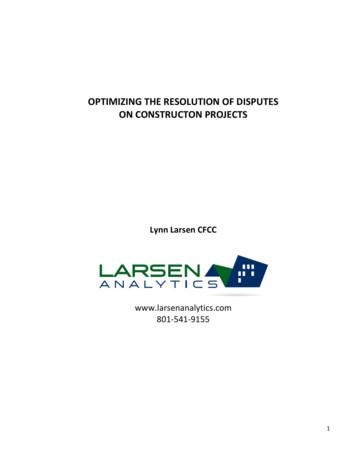Alternative Dispute Resolution In India And The United .
Alternative Dispute Resolution in India and the United States:A Comparative Analysis and Recommendations to Improve Efficiencyand Effectiveness in Indian ADRMalikul S. MuhamadIn conjunction with:Cornell UniversityJ. Purushotham & AssociatesSwami Vivekananda Youth Movement
2TABLE OF CONTENTSIntroduction 3ADR in the United States . 3-8Development of ADR in the United States .3ADR Methods .4Benefits . .6ADR Success in the United States . 7ADR in India .9-14Dispute Resolution Process in India .9Types of Industrial Disputes .12Development of ADR in India .12Litigation in India—The Need for ADR 13Factors Hindering ADR Success in India .14Suggestions to Improve ADR in India . .16Conclusion 19Bibliography .20
3IntroductionAccess to the courts is an indispensable right given to citizens in democratic countries ascourts are important granters of justices in most cases. However, litigation is not alwaysnecessary or efficient in many areas of the law, including civil and labor and employment law.Many times, parties have the opportunity to settle their disputes on their own or by using othersimpler, less expensive, faster, and more efficient methods. In fact, in the United States, theabove stated reasons have led to the use of non-formal justice for legal dispute resolution, orotherwise known as alternative dispute resolution (ADR). ADR is the use of various methods toresolve a dispute as an alternative to litigation. This ultimately reduces the burden on the courts,and allows for easier, more cost effective, and more efficient way to resolute disputes. ADR canbe very useful for all parties involved and it is therefore not surprising that ADR is veryprevalent as opposed to litigation in the U.S. Unlike the U.S. with its substantial experience inADR, the system is not very prevalent nor effective in India largely due to the intervention ofemployer and employees‟ unions and people representatives. The purpose of this paper is tocompare ADR in the United States and in India, and to consider some methods for increasedeffectiveness in India.ADR in the U.S.Development of ADR in the U.S.ADR in the United States originated from English common law is speculated to have firstexisted in New York City during the Dutch and British colonial periods whereupon pilgrimcolonists preferred to use their own mediation process to deal with community conflicts insteadof the courts.1 ADR was used sporadically hence forth and it was not until the late 19th centurydid ADR receive formal institution in the U.S. In 1898, Congress authorized mediation forcollective bargaining disputes such as the Board of Mediation and Conciliation for railway laborand the Federal Mediation and Conciliation Services (FMCS). Still, ADR was not seen as anadequate alternative to litigation but rather a tool to avoid unrest.In the 1920s, as states began taking more interest in systematic ADR as an alternative tolitigation, modern arbitration laws were passed, and Congress enacted the Federal Arbitration1Michael McManus & Brianna Silverstein, “Brief History of Alternative Dispute Resolution in the United States,”Cadmus Journals (2011).
4Act, all of which strengthened the ADR movement in the U.S. The largest improvement to thenature of ADR was that it allowed authorization for courts to enforce ADR remedies.2 Further, in1926, the American Arbitration Association (AAA) was formed provide guidance to ADRmethods.The ADR movement became especially prominent in the 1970s in the need to addressincreased delay and expense in litigation.3The system continued to grow in popularity includingat the governmental level as state and federal governments began using ADR to facilitate speedyresolutions. In 1998, Congress adopted the Alternative Dispute Resolution Act which requiresfederal district courts to establish at least one ADR program and to develop procedural rules forits use.4Perhaps most notable for its success was when ADR was introduced at the academiclevel as universities and law schools provided ADR training and relevant courses and degrees, allof which seek to introduce students away from traditional litigation and towards ADR. Today,ADR has become institutionalized in the legal field as law firms, businesses, and individualshave commonly turned to the mediation, negotiation, or arbitration to settle disputes in a fasterand more cost effect manner compared to traditional litigation. ADR has thus becomeinstitutionalized in the U.S.ADR MethodsCurrently, there are over twenty different alternative proceedings for settling legal disputes.5 Thetypes of ADR can be divided into three categories: adjudicative, evaluative, and facilitative.6 Themost common forms of ADR are described below. Adjudicative ADR: A neutral, impartial facilitator serves as the adjudicator or decisionmaker. This system is preferable to parties unwilling to negotiate yet still prefers to avoidlitigation.2Michael McManus & Brianna Silverstein, “Brief History of Alternative Dispute Resolution in the United States,”Cadmus Journals (2011).3Scott Brown, Christine Cervenak& David Fairman, “Alternative Dispute Resolution Practitioners Guide,” USAID,n.d. Web.4Elena Nosyreva, “Alternative Dispute Resolution in the United States and Russia: A Comparative Evaluation,”Annual Survey of International and Comparative Law (2001): Vol. &L Iss: 1, Article 3.5"Dispute Resolution Processes." American Bar Association. ABA, 2017. Web.6Michael McManus & Brianna Silverstein, “Brief History of Alternative Dispute Resolution in the United States,”Cadmus Journals (2011).
5o Arbitration: Arbitration is a binding adjudicative process headed either by one orseveral individuals to make a decision about the dispute after receiving evidenceand hearing arguments from both sides. Arbitration is regularly used in casesrequiring expert decision. Parties must agree on the rules of procedure andamount of discovery allowed and the determination of the arbitration is binding.o Neutral Fact Finding: Neutral fact-finding is an adjudicative procedure used insituations where parties cannot agree on the facts or expertise is necessary. Evaluative ADR: Evaluative ADR is a process where lawyers present their case andreceive feedback on their arguments.o Peer Evaluation: In peer evaluation, attorney appear before a neutral attorney ofpanel of attorneys and present the case. The panel may offer insights,recommendations for argument development, and recommendations forsettlement.o Lay Evaluation or Summary Jury Trial: In lay evaluation or summary jury trial,attorneys make an abbreviated case presentation to a mock jury, partyrepresentatives, and a presiding judge. The mock jury renders an advisory verdictthat can be helpful in getting a settlement. This proceeding gives the party a senseof how an actual jury may decide.o Judicial Evaluation: A retired judge provides feedback to the parties of the meritsof the dispute. Facilitative ADR: In facilitative ADR, the neutral‟s decision is not binding and theneutral does not reach the merits of the dispute but instead serves more as an advisor tothe parties to encourage discussion and settlement.o Mediation: Mediation is the least adversarial form of ADR as the mediator helpsthe parties identify the issues, frames the discussion, and generate options forsettlement. The goal is to bring opposing parties together to find a resolution thatis mutually acceptable.o Conciliation: Conciliation is a more informal process to mediation whereupon theconciliator may hold conversations over telephones as opposed to regular inperson meetings in mediation.
6BenefitsEfficientMany times, courts can be employ complex, lengthy procedures that can cause significantcase backlog, whereas ADR can streamline the procedures to resolve disputes quicker andaccelerate case disposition. A dispute can be settled much sooner with ADR compared tolitigation by weeks and even months. In a study conducted by the State Justice Institute at theUniversity of North Carolina, a comparison of cases assigned to mediated settlement conference(MSC) and cases directed to the superior court show that the MSC program reduced the medianfiling-to-deposition time by about seven weeks (USAID article, 19, find citation).Less CostlyParties save money they would have spent on attorney fees, court costs, experts‟ fees,discovery, and other litigation expenses. Especially with how long litigation tends to be, theexpense incurs quickly and vastly, making ADR a better alternative. One study done by theWorld Bank measuring the effectiveness of ADR found that ADR in general saved about 500per party than had they gone to litigation.7 It is important to note that cost within ADR varies aswell; however, in general, most of the types of ADR have the potential to be more effective andless costly than litigation.PersonalAs a more informal process, ADR provides a greater platform for parties to share theirstories and explain exactly what they want, which is really important for integrative bargaining.Ultimately, ADR afford parties with a greater role in shaping the process and the outcomethrough more direct participation in the process and in designing settlements. According to aUSAID article written by ., many users of ADR services in the United States cite the flexibilityand creativity of the process and settlements as better for the parties than the decisions producedthrough litigation.8Additionally, ADR programs may take into local conditions as opposed tocourts which tend to be more centralized. Lastly, ADR can deal with specialized cases that courtsare not as well-equipped to handle such as some labour-management disputes. Specialized ADRprograms focus on specific types of technical or complex disputes which can be more effectiveand produce better results than courts.7Inessa Love, "Settling out of Court: How Effective is Alternative Dispute Resolution," The World Bank (2011).Scott Brown, Christine Cervenak & David Fairman, “Alternative Dispute Resolution Practitioners Guide,” USAID,n.d. Web.8
7ConfidentialPublic records are not kept which makes ADR attractive for disputants who would preferto keep facts of the case private. This may be beneficial for many businesses, sexual assaultvictims, or anyone else who would otherwise prefer the public not to know.Increased AccessADR programs can increase access to justice for social groups that are not adequatelyserved by the judicial system. Litigation requires resources that are generally not available tosome low-income communities, such as attorney costs. Additionally, distance from courtsimpairs effective use for rural populations and ADR programs can be adapted to set up invirtually any community.Increase SatisfactionWith greater control over the process and outcome and a result of the otheraforementioned benefits, satisfaction among the parties tend to be higher in ADR systems.Additionally, in litigation, there is usually a winner and loser. The winner may not be completelysatisfied, and the loser is definitely not happy. ADR can help parties achieve mutual agreement,which can increase satisfaction for both parties.Preserve RelationshipsADR is usually a less adversarial and hostile way to resolve disputes. For example, amediator can help parties communicate their needs and understand the other parties point of viewwhich can be advantageous for parties that have a relationship to preserve.9 Additionally, in theabsence of an adversarial system where usually one party is dictated the winner and the other aloser, the parties are free to come to a mutual agreement where both sides leave happy and therelationship undamaged.ADR Success in the United StatesAccording to the statistics provided by the Department of Justice, in 2017, over 15million was saved from litigation or discovery expenses, 14,000 days of attorney and staff time9"ADR Types & Benefits.” Judicial Council of California, n.d. Web. 10 July 2018.
8saved, and almost 2,000 months of litigation avoided.10 Clearly, ADR is a more efficient andcost-effective means to resolving disputes, thereby highlighting its significance.In terms of employment relations in America, there has been an observed rise ofemployment arbitration.11 This is can be attributed to the relatively large punitive damage awardsof litigation that many employers do not want to risk and also as a result of many courts choosingto defer cases to ADR to prevent case backlog. This can be beneficial to both parties asemployees tend to win larger settlement rates than through litigation. Many consumer andemployment contracts now contain mandatory arbitration clauses as a result.12 The success ofmandatory arbitration procedures in terms of length of procedure and settlement rates remainshighly contested but the fact remains, the benefits of ADR stem larger than just length and costwhich can even larger implications.Perhaps the most notable success of ADR in the U.S. can be attributed to the FederalAviation Administration (FAA).13 Through an analysis of the 2013 case management statisticsprovided by Office of Dispute Resolution for Acquisition, it is observed that there were 893cases filed and of those, 124 were considered pre-dispute and of those, 97% was resolvedthrough ADR and only 2 cases resulted in litigation. Out of the 893, 20 were contract disputesand of which, 182 (90%) was resolved via ADR and the remaining 20 went through adjudication.This scenario can observed in many industries in the United States including businesses,construction, private matters, and many more. The success of the programs can perhaps beattributed to increased awareness of ADR because of the cost and time savings, among the otheraforementioned benefits.10"Alternative Dispute Resolution at the Department of Justice: Statistical Summary," The United States Departmentof Justice, n.d. Web. 10 July 2018.11Alexander Colvin & Kelly Pike, "The Impact of Case and Arbitrator Characteristics on Employment ArbitrationOutcomes," Cornell University ILR School, 2012.12Carrie Menkel-Meadow, " Regulation of Dispute Resolution in the United States of America: From the Formal tothe Informal to the „Semi-formal‟," Georgetown University Law Center, 2013.13“Office of Dispute Resolution for Acquisition: Case Management Statistics," Federal Aviation Administration,2013.
9India ADRDispute Resolution Process in IndiaSection 10 of the Industrial Disputes Act provides that when an industrial dispute occurs, theappropriate government may refer the industrial dispute to:1. to a works committee, or2. to conciliation officer, or3. to a board of conciliation officers, or4. to an arbitrator, or5. to a court of inquiry, or6. to a labour court of adjudication, or7. to an industrial tribunal or national tribunal to promote settlement. 14Any employer or workman must notify the appropriate government that an industrial disputeexists who then refers the dispute. The procedures are more closely outlined below:Works CommitteeAccording to Section (3) of the ID Act, the appropriate government may require theemployer to constitute a 'Work Committee‟ to resolve an industrial dispute. The commute shallconsist of equal number of representatives of employers and workmen engaged in theestablishment. The representatives of the workmen shall be chosen from the establishment.Works committee deals with the workers problem arising day to day in the industrialestablishmentConciliation OfficerAccording to Section (4), the appropriate government may appoint a conciliation offer tomediate a dispute where bilateral discussions will be held. The government maintains a systemof conciliation officers at the district, regional, and state level to serve as conciliation officers. 15The officer is empowered to inquire into the dispute and suggest solutions to bring the parties toan agreement. It closely resembles the mediation process and in the case of the private sector, thesolutions need not be accepted by the disputants. If the conciliation officer fails to resolve thedispute, he may submit a failure report of the meeting with his recommendations to theappropriate government. The government may then decide to refer the dispute to the board,1415S. K. Malik, Commentary on the Industrial Disputes Act, 1947 (Jodhpur: Rajasthan Law Hose, 1998), 384.Ibid.
10labour court, or the tribunal for adjudication. Workers are prohibited from going on strike duringthe pendency of conciliation proceedings, similarly the employers are prohibited from declaringlockouts.Board of ConciliationAccording to Section (5), the appropriate government may constitute a Board ofConciliation to settle an industrial dispute. A board shall consist of an independent chairman andtwo or four other members. The chairman is independent of the parties and the other membersare appointed to represent the parties to the dispute. In case of failure of settlement, the boardshould send the government a report of facts relating to the dispute and the board‟s opinion.ArbitrationUnder section 10(a) of the ID Act, parties may agree to refer the dispute to arbitration anytime before it is referred to adjudication. The Act requires parties to sign an arbitrationagreement specifying the terms of the reference and the names of the arbitrator(s). Once theagreement is signed, the government has the power to prohibit any strikes or lockouts during thependency of the dispute. The arbitrator‟s decision is binding.Court of InquirySection (6) establishes the court of inquiry to investigate any matter in connection with adispute. The court‟s only purpose is to inquire and submit its findings to the appropriategovernment. Like labor courts and industrial tribunals, the court has powers equivalent to a civilcourt. The court of inquiry has a time limit of six months from the commencement of the inquiryto submit its report to the appropriate government. The government occasionally uses the courtto buy time or to cool off hot-headedness that might arise form an industrial dispute.16Labour CourtUnder 11 and 11(a) of the ID Act, the government may refer industrial disputes relatingto any matter specified in the Second Schedule for adjudication. 17 Second Schedule includesmatters connected with disciplinary action taken by the employer or his workmen, illegallockouts and strikes, and interpretation of standing orders. Generally, a labour court consists of asingle person with specified qualifications. Decisions of the labour court may be appealed byeither party in the high court.16Paul Lansing & Sarosh Kuruvilla, "Industrial Dispute Resolution in India in Theory and Practice," CornellUniversity ILR School, 1987.17Industrial Disputes Act, 1947.
11Second Schedule:a. The propriety or legality of an order passed by an employer under the standing orders;b. The application and interpretation of standing orders;c. Discharge or dismissal of workmen including reinstatement of, or grant of relief to,workmen wrongfully dismissed;d. Withdrawal of any customary concession or privilege; ande. Illegality or otherwise of a strike or lock-out.Industrial TribunalThe appropriate government may refer under Section 10(1)(d) to the industrial tribunalfor adjudication for disputes relating to matters specified in the second or third schedule in theIndustrial Disputes Act. The tribunal shall consist of one person of highly qualified credentials.The tribunals are set up to complement labour courts and are required to follow the generalprinciples followed in all civil courts.Third Schedule:a. wages including the periods and mode of payment;b. compensatory and other allowa
4Elena Nosyreva, “Alternative Dispute Resolution in the United States and Russia: A Comparative Evaluation,” Annual Survey of International and Comparative Law (2001): Vol. &L Iss: 1, Article 3. 5"Dispute Resolution Processes." American Bar Association. ABA, 2017. Web.
Dispute Resolution: Options Dispute resolution procedures can be split intotwo categories. The first category isformal dispute resolution, primarilyinvolving court adjudication. The second category is a more informal option for parties andis labeledAlternativeDispute Resolution(ADR). Thiscategory includes negotiation, mediation and arbitration.
Pepperdine Caruso Dispute Resolution Law Journal Since 2000, the Pepperdine Caruso Dispute Resolution LawJournal (DRU) has been committed to publishing articles that explore Alternative Dispute Resolution (ADR) under various contexts.With support from the Straus Institute for Dispute Resolution
Research Journal of English Language and Literature . 59-65. 8 Catherine Price, Alternative Dispute Resolution in Africa: Is ADR the Bridge Between Traditional and Modern Dispute Resolution?, 18 Pepperdine Dispute Resolution Law Journal pg 395 (2018) Available . 18 Pepperdine Dispute Resolution L
Alternative Dispute Resolution Information Packet Overview & History Alternative Dispute Resolution (ADR) is an increasingly popular option that allows people to resolve disputes outside of court in a cooperative manner. ADR can be faster, cheaper, and less stressful than going to court.
2.4 Dispute Resolution Board (DRB) 3 4 The Dispute Resolution Board (DRB) process provides an independent non-binding recommended resolution of a disagreement from skilled construction savvy individuals in "real time." Those individuals are preselected by the parties to the contract and are available to advise the resolution of a dispute at the .
The Efficacy of Alternative Dispute Resolution (ADR) in Labour Dispute Resolution: A Critical Comparative Analysis of Botswana, South Africa and Zimbabwe By Bernard Bushe Student No: 31748546 Dissertation in fulfillment of the requirements of the degree of Master of Laws (LLM) University of South Africa Supervisor: Prof Mpfariseni Budeli-Nemakonde
Pepperdine Dispute Resolution Law Journal by an authorized editor of Pepperdine Digital Commons. For more information, please contact josias.bartram@pepperdine.edu , anna.speth@pepperdine.edu. Recommended Citation Catherine Price,Alternative Dispute Resolution in Africa: Is ADR the Bridge Between Traditional
2.1 ASTM Standards: 2 E 178 Practice for Dealing with Outlying Observations E 867 Terminology Relating to Vehicle-Pavement Systems E 1364 Test Method for Measuring Road Roughness by Static Level Method F 457 Test Method for Speed and Distance Calibration of a Fifth Wheel Equipped with Either Analog or Digital Instrumentation 3. Terminology 3.1 Definitions: 3.1.1 aliasing—in the context of .























